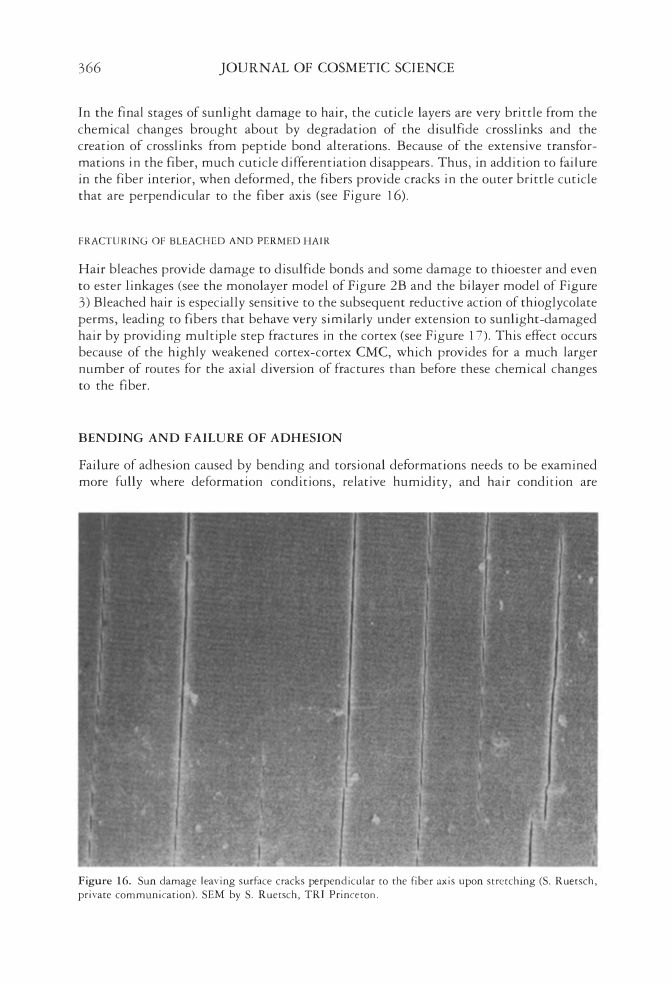366 JOURNAL OF COSMETIC SCIENCE In the final stages of sunlight damage to hair, the cuticle layers are very brittle from the chemical changes brought about by degradation of the disulfide crosslinks and the creation of crosslinks from peptide bond alterations. Because of the extensive transfor mations in the fiber, much cuticle differentiation disappears. Thus, in addition to failure in the fiber interior, when deformed, the fibers provide cracks in the outer brittle cuticle that are perpendicular to the fiber axis (see Figure 16). FRACTURING OF BLEACHED AND PERMED HAIR Hair bleaches provide damage to disulfide bonds and some damage to thioester and even to ester linkages (see the monolayer model of Figure 2B and the bilayer model of Figure 3) Bleached hair is especially sensitive to the subsequent reductive action of thioglycolate perms, leading to fibers that behave very similarly under extension to sunlight-damaged hair by providing multiple step fractures in the cortex (see Figure 17). This effect occurs because of the highly weakened cortex-cortex CMC, which provides for a much larger number of routes for the axial diversion of fractures than before these chemical changes to the fiber. BENDING AND FAILURE OF ADHESION Failure of adhesion caused by bending and torsional deformations needs to be examined more fully where deformation conditions, relative humidity, and hair condition are Figure 16. Sun damage leaving surface cracks perpendicular to the fiber axis upon stretching (S. Ruetsch, private communication). SEM by S. Ruetsch, TRI Princeton.
ADHESION FAILURE IN HAIR 367 Figure 17. Multiple step fractures from stretching hair previously bleached and permed (S. Ruetsch, private communication). SEM by S. Ruetsch, TRI Princeton. controlled systematically. Scale lifting caused by bending deformations (Figure 18) during fiber knotting, especially in the dry state, is very similar to extension-caused scale lifting and most likely involves outer beta-delta failure, particularly at low and moderate RHs. However, the condition of the hair and other variables must be considered to understand this phenomenon more fully. ADHESION FAILURE FROM ALTERNATING TREATMENTS OF ANIONIC AND CATIONIC SURFACTANTS Alternating treatments of anionic and cationic surfactants on hair fibers that have been previously permanent waved can provide adhesion failure and scale lifting (Figure 19). This type of failure occurs only in damaged hair, and it occurs more readily on hair that has been permanent waved on the head and stressed by shampooing, combing, and other stresses that are normally encountered in everyday wear. Hair permed in the laboratory can also provide this effect, but not to the same degree. Hair permed in the laboratory and then combed responds more than uncombed and permed hair, but still not to the same degree as hair permed on the head and exposed to normal wear and weathering actions. Extensively bleached hair can also provide this type of response, but not to the same degree as hair permed on the head. Undamaged hair does not provide this type of adhesion failure. As indicated above, alternating treatments of anionic and cationic surfactants can pro duce this effect. In this reaction, anionic surfactants that are larger and more hydrophilic
Purchased for the exclusive use of nofirst nolast (unknown) From: SCC Media Library & Resource Center (library.scconline.org)






































































































